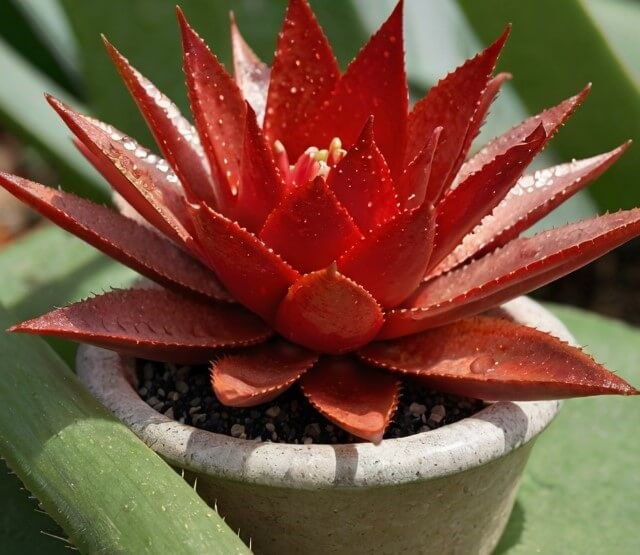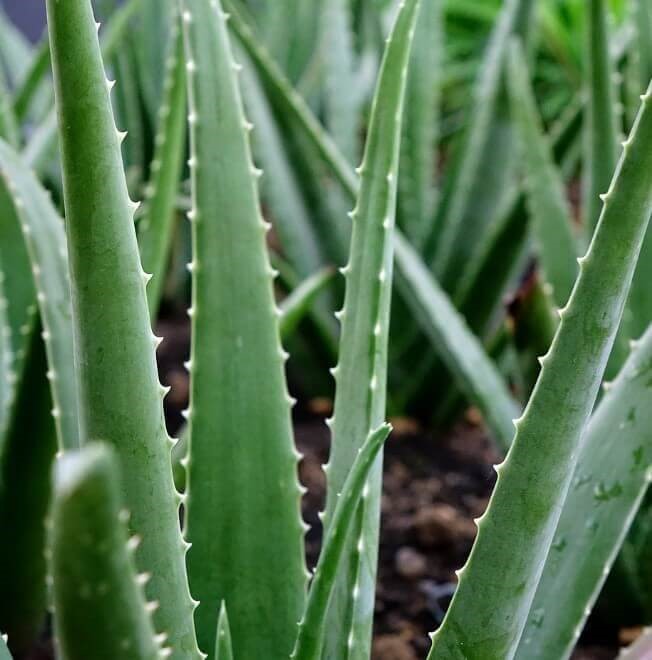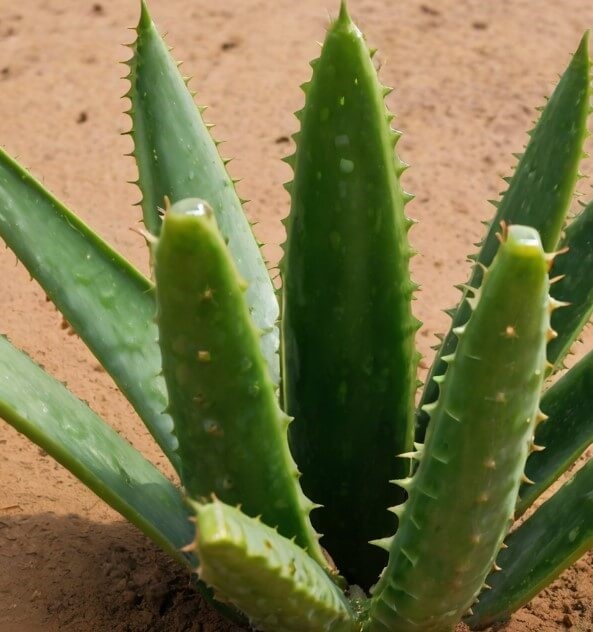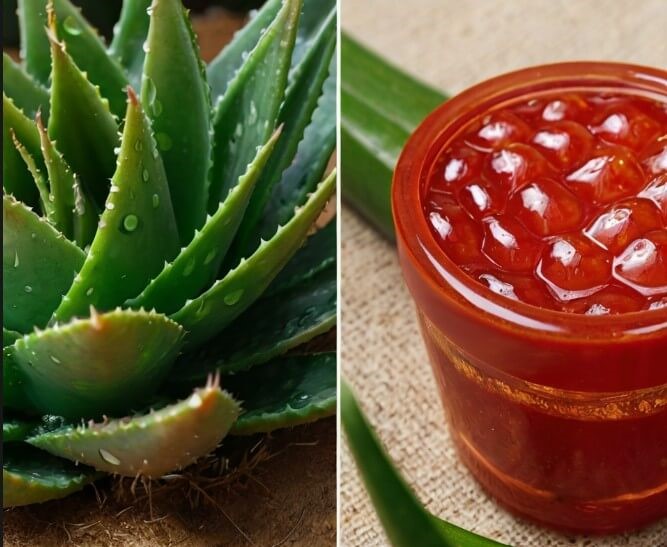Aloe vera is a famous herb for its various medicinal and skincare properties. It has been used for centuries for its health and beauty-related qualities. The herb is highly revered in Ayurveda as a ‘miracle plant’. The name of Aloe vera has an interesting history. It has derived its name from the Arabic word “Alloeh” and the Latin word “vera”. Alloeh means “a shining bitter substance”, and vera means “true”. Ancient Greek scholars and physicians described aloe vera plants as having powerful healing properties. The Egyptians used to call aloe vera the “plant of immortality”. As much as in ancient times, modern science also holds aloe vera in high importance due to its high medicinal value. It is equally interesting to know that aloe vera has many varieties and some are far more beneficial than commonly found. This article will explore red aloe vera vs green aloe vera.
What is Red Aloe Vera?

Image courtesy: Wikipedia.org
Aloe vera has many species and red aloe vera is one of them. The botanical name of red aloe vera is Aloe cameronii. Other names used for red aloe vera are Cameron’s Ruwari Aloe and Starfish Aloe. It is native to Africa, particularly Malawi and Zimbabwe. It belongs to the Asphodelaceae family which includes other types of Aloe plants. The plants of this family are known for their thick, fleshy leaves, which help them store water and survive in dry conditions. Red aloe vera is known for its vibrant red or copper-colored leaves when grown in sunlight. Red aloe vera grows in limited areas of India, mainly in hot and arid regions. It is claimed that red aloe vera has far more powerful properties than commonly found green aloe vera. Due to its potent medicinal benefits red aloe vera is a much sought-after variety. Interestingly, few people know the benefits of red aloe vera.
Nutritional Profile of Red Aloe Vera
Red aloe vera has a wealthy nutrient profile, including essential amino acids, enzymes, vitamins, minerals, and strong antioxidants like Anthraquinone. Let us look at the unique nutritional components of Red Aloe Vera.

1.) Amino Acids
Red Aloe vera contains 34 amino acids of which 7 are essential ones that our body cannot produce. These amino acids are needed for the proper growth and repair of body tissues, providing energy, muscle building, maintaining healthy skin, hair, and nails, and proper digestive and immune systems. Low levels of essential amino acids can affect muscle strength.
2.) Vitamins
Red Aloe vera is a rich source of vitamins C and E, vitamin B3, vitamins A and B12, and folic acid.
3.) Minerals
Red Aloe vera contains essential minerals like calcium, magnesium, and potassium. It also contains trace amounts of zinc and manganese.
4.) Saccharides (Natural Sugars)
Red aloe vera also contains various saccharides such as polysaccharides which have immune-boosting and anti-inflammatory properties.
5.) Other Compounds
Red Aloe vera contains glycoproteins and sterols known for their anti-inflammatory, collagen, and immune-boosting properties. It also contains enzymes such as amylase and catalase which help in digestion and cellular functions.
Benefits of Red Aloe Vera
Red Aloe vera is known as the king of the Aloe family due to its potent medicinal benefits.

1.) Anti-inflammatory Properties
Red aloe vera is especially beneficial for people suffering from arthritis and skin inflammation due to glycoproteins and sterols. Glycoproteins and sterols in red aloe vera possess strong anti-inflammatory effects. These compounds help reduce swelling, soothe irritated tissue, and promote natural healing.
2.) Skin Benefits and Wound Healing
Red aloe vera benefits skin repair and hydration due to the high amount of vitamin C and polysaccharides. Its natural sugars and enzymes improve skin elasticity. The red aloe vera gel has soothing and healing properties and is effective for sunburns, cuts, and scrapes.
3.) Strengthens Immune System
The polysaccharides in red aloe vera help the body respond better against infections. It can enhance the white blood cell activity needed to fight off pathogens. Red aloe vera has antiviral, antibacterial, and antifungal properties.
4.) Benefits Digestive Health
Red aloe vera is very beneficial for the overall digestion system because of the presence of enzymes and fibers. Also, 99% of aloe is water which is equally necessary for efficient digestion. Red aloe vera can especially be beneficial in the case of constipation. By balancing gut bacteria it improves nutrient absorption and supports the entire digestion system.
5.) Other Health Benefits
Red aloe vera is effective in managing blood pressure and lowering cholesterol levels. It can provide relief from headaches, infections, and inflammation. It is effective in treating skin disorders like eczema and psoriasis.
What is Green Aloe Vera?

Image courtesy: needpix.com
Green aloe vera is the commonly available form of aloe vera. Its botanical name is Aloe barbadensis miller. Grown in the dry regions of Africa, Asia, Europe, and America, it is a shrub-like, robust, and drought-resistant plant. It has thick, triangle-shaped leaves with serrated edges, yellow flowers, and fruit with many seeds. The gel of Aloe, the clear and jelly-like part of the leaf, is 99% water. Rest contains beneficial compounds like amino acids, fats, vitamins, and sugars, responsible for aloe’s soothing and hydrating properties. The bitter, yellowish sap is laxative and contains beneficial medicinal compounds like anthraquinones and glycosides.
Nutritional Profile of Green Aloe Vera
With 75 active constituents, aloe vera contains vitamins, enzymes, minerals, sugars, lignins, saponins, salicylic acids, and amino acids.
1.) Vitamins
It contains vitamins A (beta-carotene), C, and E which are antioxidants. The beta-carotene in aloe vera can benefit eye health. It also contains vitamin B12, folic acid, and choline. Antioxidants help fight off free radicals and save our cells from damage.
2.) Minerals
It contains calcium, chromium, copper, selenium, magnesium, manganese, potassium, sodium, and zinc.

3.) Enzymes
Aloe vera contains 8 enzymes, some of which reduce excessive inflammation when applied to the skin, while others help break down sugars and fats.
4.) Sugars
It contains monosaccharides (glucose and fructose) and polysaccharides. The sugars in aloe vera can help with digestion and wound healing.
5.) Anthraquinones
Aloe vera has 12 compounds called anthraquinones. These natural chemicals found in the plant are used for their laxatives and help in constipation. Two of the above compounds, aloin, and emodin, have additional benefits of relieving pain, killing bacteria, and fighting viruses.
6.) Other Nutrients
Aloe vera contains fatty acids that have anti-inflammatory, antiseptic, and analgesic properties. It contains 20 of the 22 amino acids needed by humans, of which 7 are essential amino acids. It also has salicylic acid which possesses anti-inflammatory and antibacterial properties. Saponins in the Aloe form 3% of the gel and have cleansing and antiseptic properties.
Benefits of Green Aloe Vera
Aloe vera has a range of health benefits. Let us look at each of these benefits:
1.) Skin Repair & Wound Healing
Aloe vera promotes collagen production and improves the collagen structure. This helps in faster wound healing. It promotes skin health by restoring natural moisture in the wounded skin.
2.) Protection from UV and Radiation Damage

Image courtesy: freemalaysiatoday.com
Aloe vera gel increases the antioxidant level of the skin helps to block harmful free radicals and reduces inflammation.
3.) Anti-inflammatory Properties
Aloe vera helps calm our body’s natural reaction to injury or irritation, also known as inflammation. This helps in reducing the discomfort and promotes faster healing. C-glucosyl chromone is a potent anti-inflammatory compound found in aloe vera gel.
4.) Strengthens Immune System
Compounds in aloe vera can strengthen the immune system. Certain animal studies have shown that aloe vera has the potential to stimulate immune cells to fight cancer. Aloe’s anthraquinones have shown antiviral and anti-tumor activities and help prevent certain cancers.
5.) Helps in Digestion
Aloe vera is a natural laxative. The anthraquinones in Aloe vera help with digestion by increasing water in the intestines and promoting bowel movements.
6.) Anti-aging Properties

Image courtesy: freemalaysiatoday.com
The moisture-binding characteristics of aloe vera promote the production of collagen and elastin in the skin. This improves skin elasticity and reduces wrinkles. The natural amino acids in aloe vera make the skin soft. Zinc in aloe acts as an astringent and tightens the pores.
7.) Antiseptic
Aloe vera contains several antiseptic agents that prevent the growth of bacteria, fungi, and viruses.
Also Read:
-
Ginger and Bay Leaf Tea Benefits – Powerful Herbal Combination
- Neem Datun Benefits: A Natural Way to Keep Teeth & Gums Super Healthy
Red Aloe Vera Vs Green Aloe Vera
Red aloe vera and green aloe vera mostly share similar compounds making them both medicinally beneficial. However, many claim red aloe vera is far more potent than its green counterpart. Let us check these claims through the red aloe vera vs green aloe vera battle.
Red Aloe Vera or Green Aloe Vera – Which Is Better?
Thanks to its unique properties, the red variety of aloe vera has established itself as a stronger alternative to the common aloe vera.
Red Aloe Vera vs Green Aloe Vera:

- The higher concentration of nutrients in red aloe vera makes it 22 times more powerful than commonly found green aloe vera.
- The amino acid content in red aloe vera is double that of common aloe vera.
- Red Aloe vera has polysaccharides 3 times higher than common Aloe vera.
- Red Aloe vera contains higher amounts of bioactive compounds like anthraquinones, glycoproteins, and sterols giving it more powerful antioxidant, antibacterial, and immune-boosting properties.
- It has more antioxidant properties than common aloe vera.
- According to the National Eczema Association website, the red aloe vera gel may relieve eczema break-outs.
- Red aloe vera was found effective in soothing burns, cuts, psoriasis, and insect bites.
- A 2016 Indian study found that red aloe vera helped regulate blood sugar levels, particularly in people with prediabetes and type 2 diabetes.
The red aloe vera was consumed in the form of crushed leaves, juice, powder, or extract. The study found that the effect of red aloe vera on fasting blood sugar levels was significant in people with prediabetes, however, it was limited in people with type 2 diabetes.
These distinctive properties make red aloe vera a clear-cut winner over green aloe vera.
Common Side Effects & Precautions
Aloe vera’s oral consumption is not recommended for pregnant and breastfeeding mothers. Also, the application of aloe vera on the skin may cause allergies in people with sensitive skin. The common symptoms of allergies may include a burning and stinging sensation, redness, swelling, and irritation. It is best to do a patch test on a small area first to look for any signs of allergy. The oral consumption of aloe may cause abdominal cramps, diarrhea, red urine, hepatitis, and worsening of constipation. Prolonged use of aloe vera is not advised as it may increase the risk of colorectal cancer. For personalized advice on which type of aloe vera is best for you and the ideal way to consume it, consulting your doctor is always recommended.
Takeaway Message
Aloe vera is a miracle plant with over 400 species. Most aloe plants contain similar compounds and characteristics. However, certain species are medicinally and nutritionally more powerful than the commonly found ones. The article delves into the comparison of red aloe vera vs green aloe vera, to understand why the red variety is hailed as superior. We have examined their distinct nutritional profiles and health benefits to explore what makes red aloe vera stand out in the kingdom of Aloe. I am sure the comparative analysis will help the readers to understand why red aloe vera stands out as a winner in this race.
Disclaimer: The views expressed in this article are the writer’s opinions and should not be considered a substitute for an expert’s advice.
What is the main difference between red aloe vera and green aloe vera?
Red aloe vera, often called “red aloe” or Kumari, has a reddish tint due to higher anthocyanin content, while green aloe vera is more common and has a lighter gel. Red aloe may have stronger antioxidant properties. Before using either aloe vera, you must consult your dermatologist.
Which is better for skin health, red or green aloe vera?
Both benefit skin, but red aloe vera is often preferred for its higher antioxidant content, which may better combat aging and inflammation. Green aloe is more hydrating and soothing. It is much easier to get naturally green aloe vera in India compared to red aloe vera.
Is red aloe vera more effective for internal use than green aloe vera?
Red aloe vera may offer enhanced detox and anti-inflammatory benefits due to its unique compounds, but green aloe is more widely studied for digestive health. Consult a doctor before internal use.
Can both types of aloe vera be used in skincare products?
Yes, both are used in skincare. Green aloe is more common in commercial products for hydration, while red aloe is gaining popularity for anti-aging and skin brightening. Red aloe vera plant is quite rare to find in India.
Are there any side effects of using red aloe vera compared to green?
Both are generally safe topically, but red aloe’s higher potency may cause skin irritation in sensitive individuals. Internally, both should be used cautiously to avoid digestive upset. Therefore, please consult your dermatologist before daily use.


1 thought on “Red Aloe Vera Vs Green Aloe Vera”